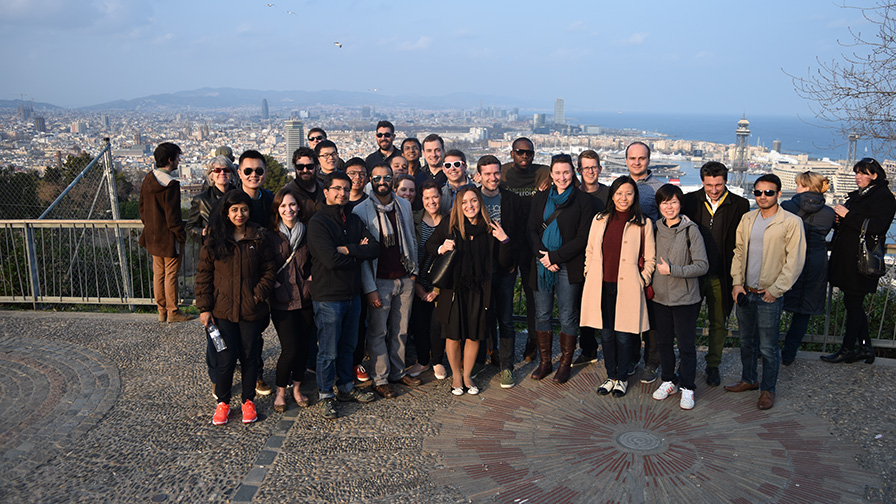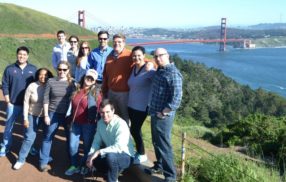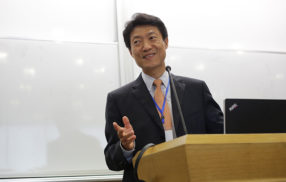
Design Thinking Sets Table for Unique Mix of Picasso, Gaudi and UVA Darden Students in Barcelona
By Ed Sykes (Class of 2017)
Some things never get old.
That’s the thought that crossed Darden Professor Jeanne Liedtka’s mind as she gazed out at the view from her favorite restaurant, nestled in the hills overlooking the Mediterranean, on the recent Global Business Experience (GBE) she led with Darden students in Barcelona, Spain.
Over the years, she has brought scores of students to Barcelona to study the intersection between business and design, and it’s moments like those that remind her what makes each visit so special.
“There’s nothing quite like taking a die-hard banker, who insists he or she has never been inspired by a building in their life, and watching their faces as they enter Sagrada Familia,” she said. “It’s one of those moments of pure emotion, and confronting of what is possible if we let ourselves dream.”
This weeklong trip is one of several GBEs offered by the University of Virginia Darden School of Business every year, designed to take students out of the classroom to explore the world and real business challenges in an international context. Barcelona, arguably the design capital of the world, is the location of choice to explore one of Liedtka’s favorite topics — the process of design thinking in business.
Liedtka is one of the foremost experts on design thinking in the business world, and she believes there are clear parallels to be found between the artistic creative process and innovative business strategy.
“Business students often say, ‘Oh ridiculous, what could I possibly learn from Picasso or an architect?’” Liedtka said.
It turns out, quite a bit.
The Power of ‘Possibility Thinking’
Famed Catalan architect Antoni Gaudí never saw a challenge he couldn’t overcome. Even when it came to planning his seminal work in the early 20th century — the breathtaking, and still-unfinished, Sagrada Familia church — Gaudí viewed his limitations as merely temporary.
“You look at the conditions, the constraints he decided to ignore — time, money, his own lifetime — and you walk into the Sagrada Familia, and it just inspires people,” Liedtka said.
This, according to Liedtka, illustrates the supreme importance of “possibility thinking” in life and in business. Whether in 19th century architecture or 21st century innovation, Liedtka says the same principles hold true — real breakthroughs occur when we actively seek to overcome perceived constraints and open up our imaginations.
“We think that the way you begin to envision a new future is by very carefully taking into account the realities of today,” Liedtka said. “The problem is, if you do that, tomorrow never really looks that different from today.”
Gaudí’s vision for the future was informed not just by his ability to dream, but also his eagerness to experiment. Using mathematics, plaster models and breakthrough design methods, Gaudí found ways to push boundaries while mitigating risk.
It’s a message that hits home for Rosie Ivanova (Class of 2017), who began her career in marketing in her home country of Bulgaria prior to Darden. As a marketer, Ivanova understands the importance of possibility thinking coupled with careful planning and experimentation.
“This really surprised me, how much effort these artists put into preparation,” said Ivanova. “We always hear about the importance of preparation in business, and in art it’s similar — experimentation and preparation helped them find the best solution.”
View photos from the students’ Barcelona GBE.
Building Your Repertoire
Beyond possibility thinking, the artistic process itself holds another lesson for would-be design thinkers: the critical importance of collecting experiences, seeking new influences and building a “repertoire,” as Liedtka refers to it.
Here, Liedtka takes a page from Picasso’s playbook. Now considered one of the 20thcentury’s most groundbreaking painters, known largely for his role in cubism, Picasso’s influences throughout his life shaped the artist he would become. This commitment to constant learning, Liedtka said, is what set him apart.
“Look at Picasso’s interests and influences — everything from Matisse to African art,” Liedtka said. “You have these colliding kinds of motivations and inspirations that are uniquely their own and allow him to produce something no one else quite could.”
The design thinking lesson is clear, but often overlooked — a wide repertoire of influences and experiences augments how an individual views the world, and can dramatically improve a manager’s approach to complex business challenges.
“We are taught to be so constrained in our thinking, we think we’re being practical,” Liedtka said. “And if we’re not careful, it’s so easy to have a narrow repertoire in our work.”
Running on Emptiness
Like Picasso, Gaudí understood the importance of building a repertoire, but perhaps more important to his creative journey was his willingness to embrace the repertoires of others through something Liedtka and other design thinkers call “emptiness.”
“It is this question of how you leave space to invite other people’s creativity in to combine with yours,” Liedtka said.
Hundreds of designers, sculptors and craftsmen have taken part in the creation of Gaudí’s Sagrada Familia over the past century, each feeling their own sense of ownership. Gaudí’s design provided a framework for his personal vision, but it also left space for others to exercise their own visions. This, Liedtka said, is an important takeaway for business strategists seeking sustainable solutions.
“How do you structure an organization that invites people in? How do you create dialogue instead of debate?” Liedtka said. “The question really becomes, how do we help people get rid of the fear? Design thinking is just a Trojan horse. It makes it safe to do something that is really quite subversive and radical underneath it all.”
Liedtka said you don’t need to travel to Spain to see these principles in action — from fast casual restaurants to software development, good design is everywhere.
“This trip forced me to look at things from a different perspective,” said Akhil Sharath (Class of 2017). “I’ve always thought of these two things as very separate, but the class provided a great link between the design elements of business and how they relate to a purely artistic process.”
In a constantly evolving world, it’s the job of current and future business leaders to recognize what drives great design across functions, and maintain a constant thirst for new possibilities.
Ed Sykes (Class of 2017) holds a Batten Media Fellowship. These fellowships are awarded through Darden’s Batten Institute of Entrepreneurship and Innovation to candidates engaged in careers at news gathering organizations who show deep commitment to careers in the news media and demonstrate high potential for achievement and leadership.
The University of Virginia Darden School of Business prepares responsible global leaders through unparalleled transformational learning experiences. Darden’s graduate degree programs (MBA, MSBA and Ph.D.) and Executive Education & Lifelong Learning programs offered by the Darden School Foundation set the stage for a lifetime of career advancement and impact. Darden’s top-ranked faculty, renowned for teaching excellence, inspires and shapes modern business leadership worldwide through research, thought leadership and business publishing. Darden has Grounds in Charlottesville, Virginia, and the Washington, D.C., area and a global community that includes 18,000 alumni in 90 countries. Darden was established in 1955 at the University of Virginia, a top public university founded by Thomas Jefferson in 1819 in Charlottesville, Virginia.
Press Contact
Molly Mitchell
Associate Director of Content Marketing and Social Media
Darden School of Business
University of Virginia
MitchellM@darden.virginia.edu






